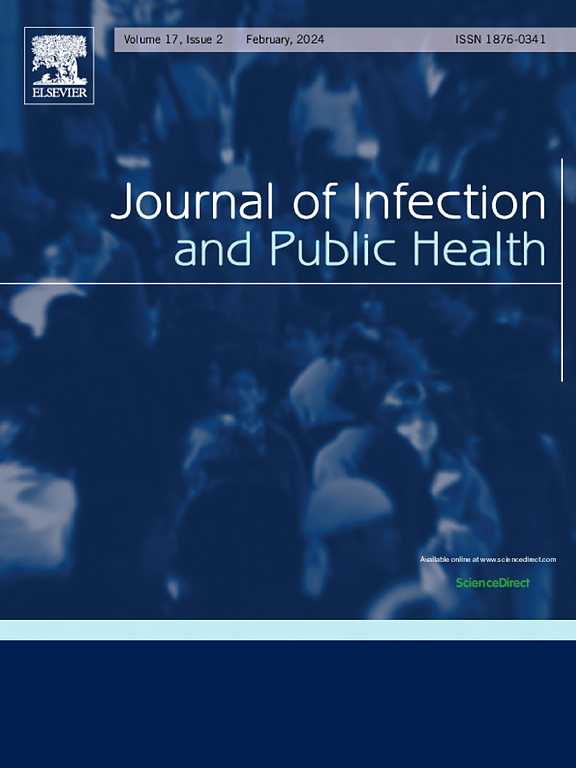泰国动物养殖场附近环境中多重耐药大肠埃希菌和克雷伯菌分离株的CTX-M、SHV、TEM和VEB β-内酰胺酶以及MCR-1。
IF 4.7
3区 医学
Q1 INFECTIOUS DISEASES
引用次数: 0
摘要
背景:目前,抗菌药物广泛应用于动物和农业,引起了多重耐药(MDR)细菌的危机。在这项研究中,我们调查了4种重要的抗微生物细菌:产β-内酰胺酶(ESBL)的大肠杆菌、肺炎克雷伯菌和沙门氏菌,以及鸡和猪场周围环境中的耐甲氧西林金黄色葡萄球菌(MRSA)。方法:分别于2020年(9个)和2023年(13个)在靠近22个动物养殖场的河滨上下游采集土壤样本44份、水体样本44份和自举样本15份。在适当的培养基中培养样品,并进一步鉴定分离菌落。除多粘菌素敏感性采用肉汤圆盘洗脱法外,其余采用纸片扩散法测定菌株的药敏和ESBL产量。采用聚合酶链反应(PCR)法检测常见耐药基因。结果:共检出大肠杆菌123株(n = 59)和克雷伯菌123株(n = 64),其中耐多药菌株25株;下游和上游地区分别有21株和4株分离株。另外,13株菌株为ESBL生产者,其中12株来自下游地区。两种细菌中最常见的ESBL基因是blaCTX-M,而在2株大肠杆菌中发现了耐粘菌素基因mcr-1。未检出沙门氏菌和MRSA。结论:畜禽养殖场周边环境中存在耐药菌,尤其是下游地区,畜禽养殖场应合理使用抗菌药物。本文章由计算机程序翻译,如有差异,请以英文原文为准。
CTX-M, SHV, TEM and VEB β-lactamases, and MCR-1 among multidrug-resistant Escherichia coli and Klebsiella isolates from environment near animal farms in Thailand
Background
Currently, antimicrobial agents are widely used in both animals and agriculture, causing the crisis of multidrug-resistant (MDR) bacteria. In this study we surveyed for 4 important antimicrobial-resistant bacteria: extended-spectrum β-lactamase (ESBL)-producing Escherichia coli, Klebsiella pneumoniae and Salmonella spp., and methicillin-resistant Staphylococcus aureus (MRSA) from the environment around chicken and pig farms.
Methods
Forty-four soils, 44 water and 15 bootstrap samples were collected from upstream and downstream of the riverside close to 22 animal farms in 2020 (9 farms) and 2023 (13 farms). The samples were cultured in appropriate media and isolated colonies were further identified. Antimicrobial susceptibility and ESBL production were tested by disk diffusion method except for colistin susceptibility determined by broth disk elution test. Common resistance genes were tested by polymerase chain reaction (PCR) methods.
Results
A total of 123 E. coli (n = 59) and Klebsiella species (n = 64) were identified and 25 isolates of them were MDR; 21 and 4 isolates from the downstream and upstream areas respectively. In addition, 13 isolates were ESBL producers, of which 12 isolates were from the downstream area. The most common ESBL gene among both organisms was blaCTX-M, whereas colistin resistance gene, mcr-1, was found in 2 E. coli isolates. Salmonella spp. and MRSA were not isolated from any sample.
Conclusions
Antimicrobial-resistant bacteria were found in the environment around the animal farms especially from the downstream area, suggesting the urgent need of judicious use of antimicrobial agents in animal farms.
求助全文
通过发布文献求助,成功后即可免费获取论文全文。
去求助
来源期刊

Journal of Infection and Public Health
PUBLIC, ENVIRONMENTAL & OCCUPATIONAL HEALTH -INFECTIOUS DISEASES
CiteScore
13.10
自引率
1.50%
发文量
203
审稿时长
96 days
期刊介绍:
The Journal of Infection and Public Health, first official journal of the Saudi Arabian Ministry of National Guard Health Affairs, King Saud Bin Abdulaziz University for Health Sciences and the Saudi Association for Public Health, aims to be the foremost scientific, peer-reviewed journal encompassing infection prevention and control, microbiology, infectious diseases, public health and the application of healthcare epidemiology to the evaluation of health outcomes. The point of view of the journal is that infection and public health are closely intertwined and that advances in one area will have positive consequences on the other.
The journal will be useful to all health professionals who are partners in the management of patients with communicable diseases, keeping them up to date. The journal is proud to have an international and diverse editorial board that will assist and facilitate the publication of articles that reflect a global view on infection control and public health, as well as emphasizing our focus on supporting the needs of public health practitioners.
It is our aim to improve healthcare by reducing risk of infection and related adverse outcomes by critical review, selection, and dissemination of new and relevant information in the field of infection control, public health and infectious diseases in all healthcare settings and the community.
 求助内容:
求助内容: 应助结果提醒方式:
应助结果提醒方式:


